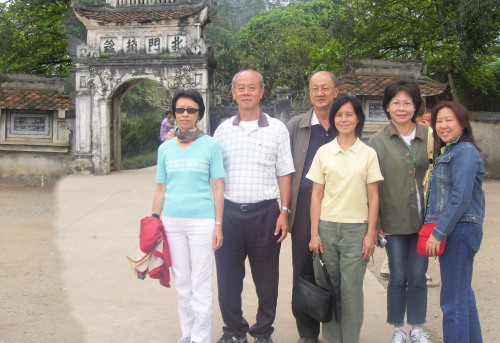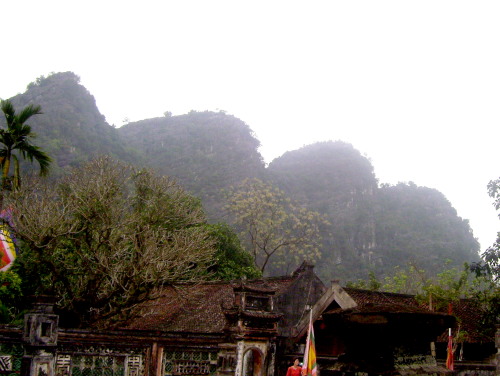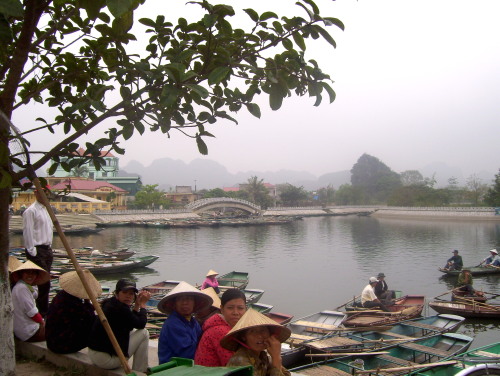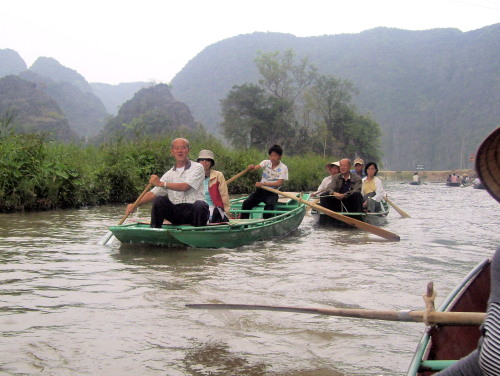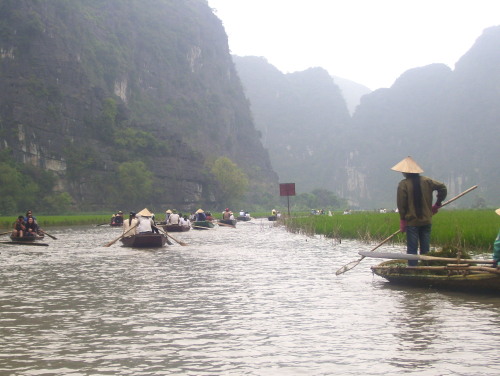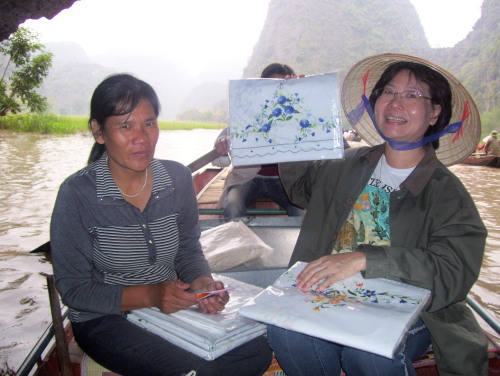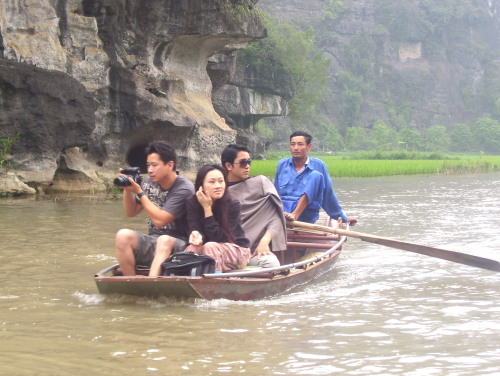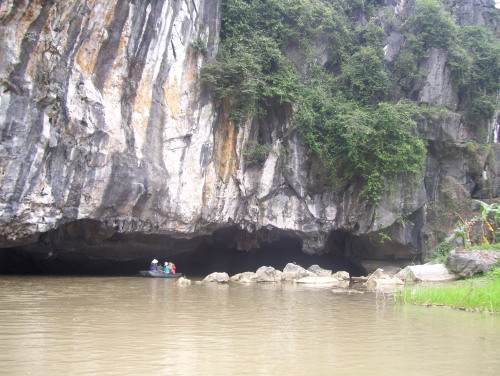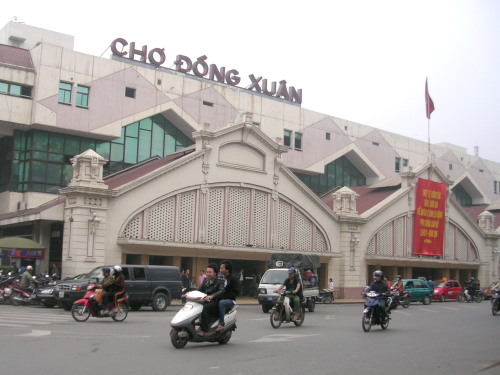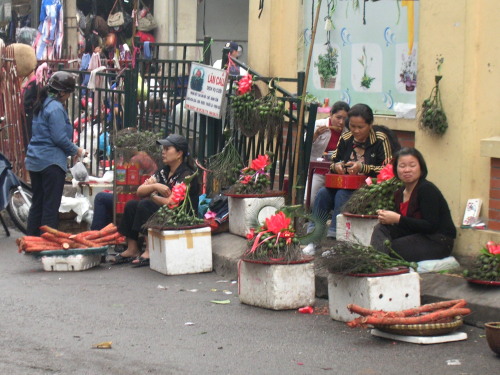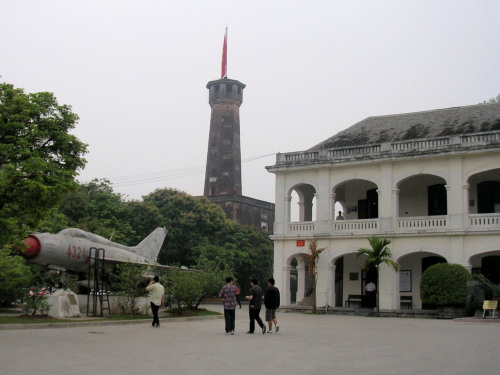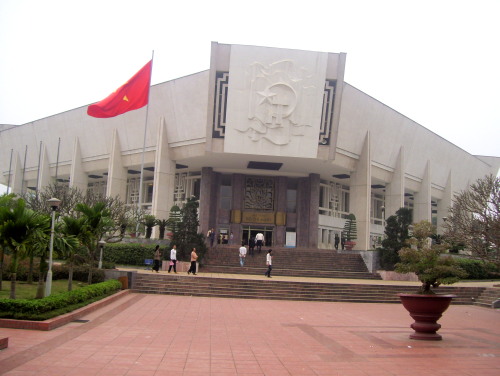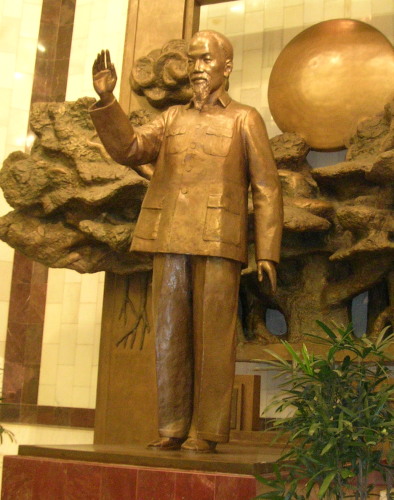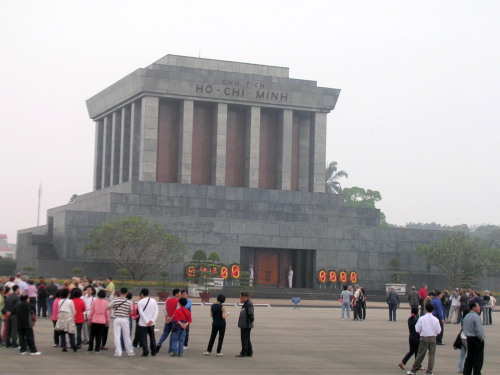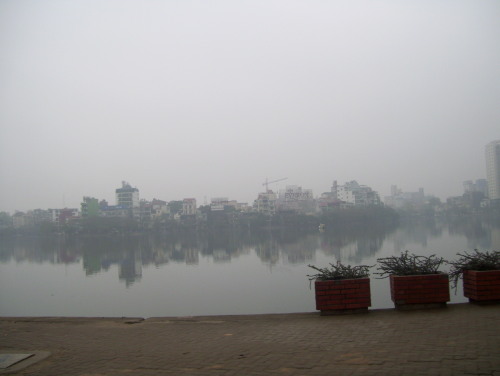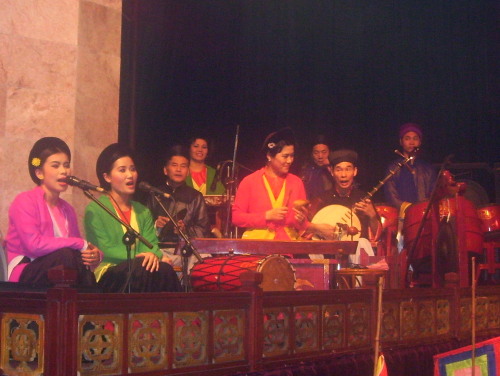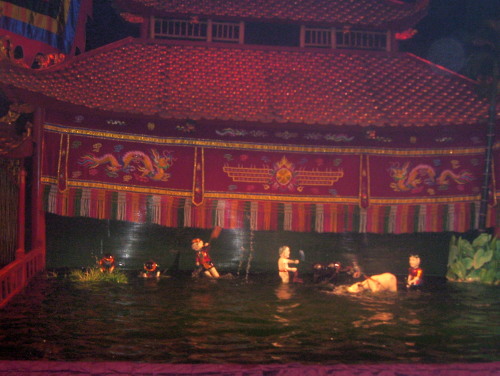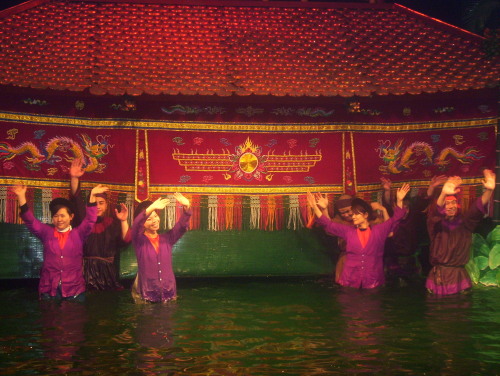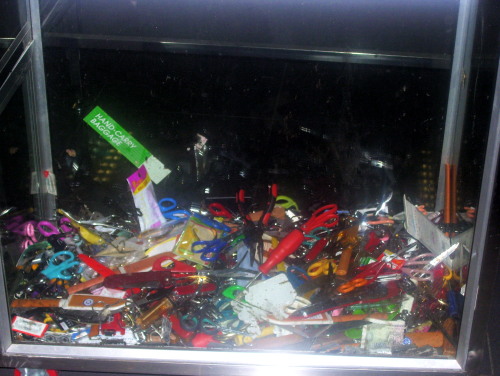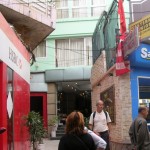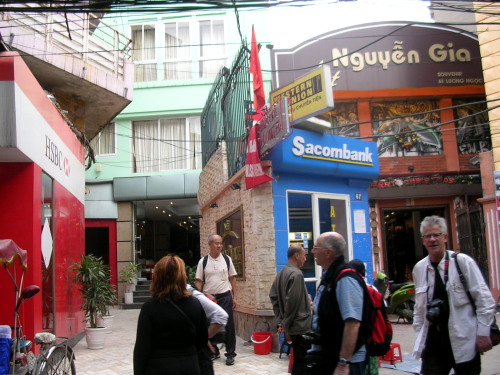Hanoi Travel II
(continue from Hanoi Travel I)
Day 3 17 March 2009
Hoa Lo
On this day, we decided to visit two places of interest, viz. H0a Lo and Tam Coc. A van came to hour hotel in the morning and picked us up. It brought us to Hoa Lo first. It is about 110 km south of
Hanoi. After two hours of travelling we arrived at a large open field in Hoa Lo. From the field, we could see high hills and temples. Hoa Lo was once an ancient capital as the hills provided protection to the dwellers then.
Temples of King Dinh and King Le
We visited two well-known temples there. There were built as shrines to the memory of two kings, King Dingh Bo Linh and King Le Hoan, who lived in the 10th. century. The temples were built like those in China but they were lower. According to our tour-guide, Cong, one day, King Dingh and two of his three sons were assassinated by some generals who wanted to overthrow him. His wife, with the help of a loyal general, Le Hoan, defeated them and made Le Loan the new king. Later, she married him and her youngest son who escaped the assassination lived with them. The first temple we visited had a
statue of King Dingh and his wife inside and the second one nearby had three statues, King Le, his wife (formerly King Dinh’s wife) and King Dingh’s youngest son.
Tam Coc (Three Caves)
Later, we left Hoa Lo and headed for a small town called Tam Coc. Tam Coc has a long, winding, shallow and slow-moving river known as Hoang Long River. It meanders in between limestone-hills and also cuts through three low caves that give the place the name Tam Coc or Three Caves. As the scenery of the hills is similar to the one in the Halong Bay, it is also known as ‘Halong Bay on Land’.
Vietnamese Boat Rowers
When we arrived at the Tam Coc wharf, we saw Vietnamese rowers waiting for tourists to board their small boats which were made of metal. Each boat can carry six adults including a paddle-man and his assistant. Before we went for the boat ride, we had lunch first at a new restaurant at the wharf. After the meal, we boarded the boats: two, three or four persons to each boat. My wife and I sat in a boat which was rowed by a 15 year old boy and his assistant, a 22 year old sister. The small and skinny boy was rowing with two long oars while her sister was rowing with a short one.
Writer Helped to Row
Later, as I felt I needed some exercise, I took over the lady’s task and enjoyed rowing upstream. As we moved along the river we saw paddy-fields and towering hills which were scenic. We also
went through three low caves which were dark inside. On one occssion, we saw two white goats grazing high up on a steep slope of a hill. A few minutes later, we saw lots of boats of tourists on their returning journey. Some of them were smiling at me and taking snap-shots as I was helping to row the boat. Along the river, I noticed some uniformed officers with an arm-band watching the river traffic. I guessed they were traffic police.
A Mysterious Metal Box
When we had travelled midway an oncoming boat came close to our boat and a man transferred a large metal box to our boat. I was wondering what was inside the box. An hour later, we came to the end of the boat-journey and had to turn
back. While we were turning back we were obstructed by a boat carrying food and drinks. The lady of the boat persuaded us to buy some food or drink for our rowers. We bought a pack of snack for the young boy.
Lady Rower Became Businesswoman
As we were going back half-way, the lady of our boat opened the metal box, took out table-cloths with simple embroidery and persuaded my wife to buy them. As my wife felt the embroidery works were not attractive and the cloths were expensive she refused to buy them. Then the disappointed lady took out other handicrafts and showed them to my wife. She became more disappointed when my wife refused to buy them too. But when we gave her and her brother a handsome tip she felt happy and friendly again.
I guessed these poor Vietnamese rowers were trying to make some extra money from tourists even though they knew they would be given tips by generous tourists.
Later, the lady transferred the box to another boat which was going upstream and I was surprised that she boarded the other boat leaving her poor tired little brother to row. As I was helping to row most of the time, she might have thought that I would continue doing so until we reached the wharf.
Leg Rowing
On the way back, I was amazed to see our young rower sit at the back and use his legs to row the boat while I was still using my hands. I also saw other rowers rowing with their legs, skillfully and
effortlessly. On arrival at the wharf, we thanked the boy who looked so tired that he could not say a word. As we disembarked the boat, a middle-aged lady talked to us in Vietnamese which we could not understand and at the same time pointed at the boy who rowed us. Then someone told me in Mandarin that the lady said that the boy was her son. In response, I stuck out my right thumb up and then pointed at the boy who was still panting. Well, that was an enjoyable boat-ride and a spectacular sight of the Tam Coc limestone hills.
Grace Gan, A Good Entertainer
Later, we left Tam Coc for Hanoi. Our return journey was an enjoyable one as we were entertained by one of our
friends, Grace Gan, most of the time, with her jokes, singing and interesting working experience tales. On arrival at the city, we had dinner at a small restaurant which had narrow staircases all the way up to the second floor. As the ground floor and the first floor of the restaurant were full of customers, we had to go up to the second floor. Luckily, our body-size was small enough to go up the staircases, otherwise we had to look for another restaurant nearby.
Puppet Show Tickets Sold Out
After dinner, we went to a famous theatre for a wooden puppet show. But we were disappointed as the tickets for the last two shows in the evening were sold out. Anyway, we tried to book for one of the following day shows. We were shocked when we were informed by the ticket-
seller that the only show that was available for booking was the 9 p.m. show which was the last show. As we had no choice we booked the tickets for that show.
Day 4 18 March 2009
Do Xuan Market
On the morning of our 4th. day in Hanoi, we left our hotel and walked to the largest Hanoi market, Dong Xuan Market. It was built in 1889 and now its building is much larger after renovation and expansion. The front part houses lots of stalls that sell goods ranging from apparels and handicrafts to electrical and electronic goods whereas the back part is wet and dry market. Dong Xuan Market is considered as the largest wholesale market in North Vietnam.
After walking for 15 minutes, we arrived at the market and were shocked to see the chaotic and appalling situation of the place behind the market. Roadside vendors set up their stalls haphazardly making the roads narrower. Motorbikes parked on the roadside in a disorderly manner and shops laid their goods in the walkway. Besides, the place was dirty and congested with both motorbikes and cars.
We spent a lot of time at the market as some of us were busy looking for something to buy like clothes and handbags, and haggling over the prices.
Vietnam Military History Museum
In the afternoon, we hired our hotel jeep for a short trip in the city. First, it brought us to the Vietnam Military History Museum in Dien Bien Phu Road in Ba Dinh District. Opened in 1958, this museum features thousands of exhibits that depict the Vietnamese military history and the wars the Vietnamese fought against the foreign invaders who were Chinese, French and the Americans. The most interesting exhibition at the museum was about the Vietnam War (1954 – 1975) when the Vietcongs were trying to conqure South Vietnam from the American imperialists.
War-Hardwares
In the compound of the museum, some war-hardwares used by the Vietcongs and the Americans during the war are on display, such as the captured American jetfighters, helicopter, tank and
artilleries, and the Russian MiG jetfighter and tank. Besides, there is a large and high pile of crashed American fighter planes near the Flag Tower. The Flag Tower which is 31 m high and was ready in 1812 is a Vietnam national cultural monument.
Ho Chi Minh Museum
The second place we visited was the Ho Chi Minh Museum. Built in 1990, it is located in the Ba Dinh Square and half a kilometre from the Vietnam Military History Museum. This large, majestic-looking building is dedicated to a great Vietnamese hero, Ho Chi Minh. It showcases his hard life, determined struggle for his country’s independence from
the French colonialists and his successful political career.
Ho Chi Minh
According to Wikipedia, Ho Chi Minh (May 19, 1890 – September 2, 1969) was a Vietnamese Communist revolutionary and statesman who was Prime Minister (1946–1955) and President (1946–1969) of the Democratic Republic of Vietnam (North Vietnam).
Ho led the Viet Minh independence movement from 1941 onward, establishing the communist-governed Democratic Republic of Vietnam in 1945 and defeating the French Union in 1954 at Dien Bien Phu. In the late 1950s, he lost political power in North Vietnam , but remained as the important figurehead president until his death at the age of 76 in 1969. He was named by Time Magazine as one of the 100 most influential people of the 20th century. When the Viet Cong captured Saigon, the former capital of South Vietnam, it named the city after Ho Chi Minh honouring their great man.
Having learned about Uncle Ho, as he was fondly called, we left the museum and walked a short distance to the place where his embalmed body was laid.
Ho Chi Minh Mausoleum
Ho Chi Minh died in 1969 at the age of 79 years old. Before his death, he wished that his body would be cremated and his ashes buried in the ground to save agricultural land.Instead, his communist party embalmed his body and placed his body in a large building near the Ho Chi Minh Museum for public viewing. The building is known as Ho Chi Minh Mausoleum.
When we reached the mausoleum we were disappointed to be informed that it was closed to public then. Later, we watched a change of guards in front of the building. Then we left the Ba Dinh Square for the largest lake in Hanoi, West Lake (Ho Tay Lake).
West Lake (Ho Tay Lake)
West Lake is in the north of Hanoi. It was a favourite place for Vietnamese royalties in the past when there were many summer houses round the lake. Nowadays, local people go there for leisure and recreaton. On arrival at the lake, we noticed that the lake was shrouded in haze. As we were all feeling tired after visiting the two museums and a mausoleum, we did not want to get down, but we asked our driver to go round the lake once. We felt the sight of the lake was scenic. But it would have been more beautiful, if the air was clear. Soon, we returned to our hotel to rest.
Water Puppet Show
In the evening, we walked from our hotel to a well-known theatre, Thang Long Water Puppet Theatre at 57B, Dinh Tien Hoang Street, to watch a wooden puppet show. We brought along our tickets which we booked the previous night.
A Pickpocket
As the 9 p.m. show was an hour away, my wife and I decided to take a walk at the Hoan Kien Lake Park for a few minutes. The park was full of people. As we were
walking towards an empty seat by the lake a thin, young man wearing a cap approached and asked me to buy his postcards. I told him I was not interested in his cards but he kept coming closer to me until his cards touched my chest. Then he walked away, quickly.
Later, my wife who suspected that guy could be a pickpocket asked me if I had lost anything, The first thing that came to my mind was my son’s expensive digital camera. Quickly, I touched my chest-pocket and it was gone! Over 400 photos I had, painstakingly, taken the last four days in Hanoi were gone too! We tried to search for the guy in the crowded park, but it was fruitless. Then, feeling unhappy about the theft, we went back to the theatre to watch the wooden puppet show.
Watching The Puppet Show
In the theatre, I tried to watch and enjoy the puppet show without thinking of the unfortunate incident. At first the show was boring, but later it became interesting and exciting and I forgot about the lost camera, momentarily.
In the olden days, farmers created puppets from wooden blocks for performing shows to entertain themselves and the villagers after every rice harvest. But they did the shows in ponds or flooded paddy fields. Nowadays, wooden puppet shows are shown in theatres in Hanoi. Both locals and foreign tourists flock to the theatres to watch an hour show, every day.
The Puppeteers
In every show, the puppeteers stand in a pool of hip-deep water behind a curtain, and using long bamboo poles and strings or wires immersed in the water they
skilfully make the wooden puppets come alive. The show is performed with the accompaniment of a live Vietnamese orchestra and rendition of two singers.
The show features 17 unrelated scenes which are mostly about traditional village life and legends. Some of the scenes can be interesting and exciting like the ‘Dragon Dance’, ‘Rearing Ducks and Catching Frogs’, ‘Fishing’, ‘Lion Dance’, ‘Phoenix Dance’ and ‘Boat Racing’. As the puppets ‘spoke’ in Vietnamese which we could not understand we tried to understand the stories by their movements and actions.
At the end of the show, eight puppeteers in brightly-coloured traditional costumes appeared in front of the curtain
clapping and waving farewell to us. We too clapped and waved goodbye to them. We felt the show was unusual and enjoyable.
Day 5
19 March 2009
Confiscated Sharp Objects
We woke up early in the morning, took our breakfast and went straight to the Noi Bai Airport to catch the 9.15 a.m. plane home, Malaysia. As we passed throught the baggage security checkpoint, we were shocked to see lots of confiscated sharp objects in a large transparent plastic box like scissors, knives, nail-cutters, etc. At about 9.30 a.m., we finally left Hanoi and were on our way home.
Well that is our short trip to Hanoi and we hope the above information is useful to the readers who intend to to go there for a visit. Our next trip will be Phuket Island in southern Thailand in June, 2009 and I will write about it after the trip.
Acknowledgement
My wife and I would like to thank the staff of Hanoi Palace Hotel at 61B, Luong Ngoc Quyen Street, Hanoi City, Vietnam for their help and hospitality during our stay there.
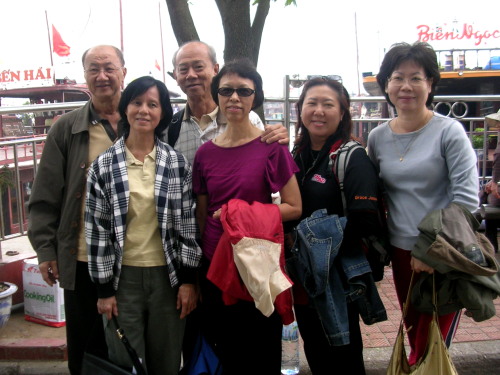
Group of Six at Hon Gai Wharf (Front row from left to right: Mrs. Chua, Writer’s wife, Grace Gan and Grace Chen; Back row from left to right: Mr. Chua and writer)
Special thanks to Lisa Duong, the General Director of the hotel for being so kind as to walk and lead us to a superstore where we could buy the famousVietnamese coffee powder cheaply.
We would also like to thank our four friends, Mr. and Mrs. Chua, Grace Chen and Grace Gan for being excellent travelling companions. Lastly but not least, I would like to thank Grace Gan for the Hanoi Trip photos. Without her photos, I do not think I would be able to write about this ‘Hanoi Travel’ .
The End
Written by:
Choo Chaw, Kluang, Johor, Malaysia.

